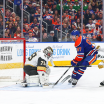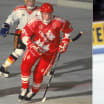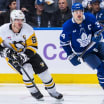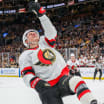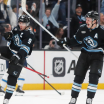MONTREAL -- We really should have seen it coming.
The signs were all there, as they have been for years, but it still seemed unthinkable that the Montreal Canadiens would choose to end their relationship with P.K. Subban so early in his NHL career.
Until they did.
Analysis: Subban trade shouldn't be surprising
Defenseman's personality, popularity didn't fit with Canadiens' approach
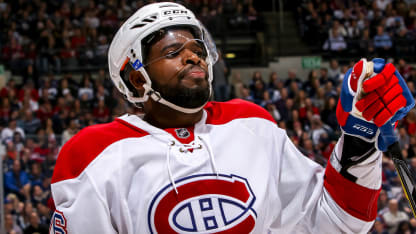
© Jonathan Kozub/Getty Images
By
Arpon Basu @ArponBasu / LNH.com Senior Managing Editor
Canadiens general manager Marc Bergevin saw an opportunity to add defenseman Shea Weber and jumped at it, trading Subban to the Nashville Predators on Wednesday, two days before a no-movement clause in his contract kicked in that covered the final six years of his agreement.
The question is: Why?
Why would Bergevin be so eager to trade an electrifying defenseman entering the prime of his career, one so attached to the city, one who has loved the Canadiens since he was a little boy growing up in enemy territory in Toronto, one who embraced everything it meant to play in Montreal, both good and bad?
The answer wasn't coming Wednesday from Bergevin,
who insisted the Canadiens were a better team with Weber instead of Subban
, but wouldn't elaborate.
But the reasons for making this trade have probably been building in Bergevin's mind since the middle of December as he watched the beginning of a Canadiens slide that dropped them from the top of the NHL standings right out of the Stanley Cup Playoffs.
He saw a team that had a leadership void in the absence of injured goaltender Carey Price, not to mention a goaltending void. With Subban's no-movement clause looming, and with his being Bergevin's most valuable trade chip, the thought of doing what he finally did on Wednesday may very well have dated back to that time.
Over a two-month period from Dec. 3 to Feb. 3, the Canadiens went 5-20-1, going from first in the League to five points out of a playoff position in the Eastern Conference.
The irony is that if there was one Canadiens player whose performance did not dip during that slump, it was Subban. He had three goals and 18 points to lead the Canadiens in scoring over those 26 games. Their next highest scorers were forwards Alex Galchenyuk and Max Pacioretty, the captain, who each had 12 points. Not only that, of the 48 goals the Canadiens scored over those 26 games, Subban was on the ice for 30 of them.
And yet, less than five months later, Subban is in Nashville.
That does not necessarily mean Bergevin blames Subban for the slide, but the fact remains the one player who maintained his level of play during that period of time was traded.
On Feb. 17, Subban had what would turn out to be his final clash with coach Michel Therrien when he turned the puck over at the offensive blue line late in a tie game at the Colorado Avalanche. The Avalanche skated down the ice in a 3-on-3 situation and wound up scoring the winning goal.
Therrien was incensed after the game and blamed Subban for the loss. Subban did not see it that way, claiming he lost an edge on the play, causing him to lose his balance, and that if he had to do it again, he would.
The episode perfectly summed up the incompatibility between Therrien and his top defenseman.
"We believe in attitude, we believe in discipline and we believe most of all in the team concept," Therrien said two days later. "Because our goal is the same goal as all of our fans, and that's to win the Stanley Cup. It's going to take those three things to do it."
The Canadiens were off the day after that game and practiced on Feb. 19. During that off day, all anyone was talking about in Montreal was Subban. There was one side saying this was another typically reckless play that cost the Canadiens a badly needed win, while the opposite camp said his willingness to attempt that type of play made Subban great.
But Subban himself probably nailed what had become a bit problematic for the Canadiens.
"Sometimes I do wish more of the attention could be on our team and not on myself," Subban said that day, "but I can't help it."
By replacing Subban with Weber, the Canadiens have eliminated the media circus that often followed Subban. That team concept Therrien loves to talk about was undermined frequently by just how popular and polarizing Subban was, with his every move on or off the ice becoming a source of controversy, or at least discussion.
Subban helped this himself by skillfully building his brand on social media and through his generous charity work. Weber does not even have his own Twitter account.
Another of Therrien's favorite sayings is that he wants the Canadiens to be "tough to play against," a term he uses as his highest form of praise. It is also a term that can be taken many different ways.
Subban could be considered tough to play against because of his tremendous ability to move the puck out of his zone, breaking down opposing forechecks perhaps better than any defenseman in the NHL. Then there's Weber, who is tough to play against because he leaves you battered and bruised, either by crunching you into the boards or forcing you to block the hardest slap shot in the NHL.
Judging by Bergevin's acquisitions of Weber and Andrew Shaw from the Chicago Blackhawks, a player who is also a physically demanding opponent, it would appear the Canadiens are moving in the direction of becoming a bruising team more than a skating team.
With the Pittsburgh Penguins' winning the Stanley Cup based largely on their speed up and down the lineup and the rest of the NHL looking to copy that blueprint, the Canadiens appear to be going in the opposite direction.
This is why the opening of free agency Friday will be so telling.
Bergevin has a serious need to add offense, a problem for the Canadiens since before he was hired in 2012. Subban helped the Canadiens offense tremendously by ensuring they spent more time playing in the opposing zone whenever he was on the ice, while Weber has 164 goals over the past 10 seasons, the most among NHL defensemen.
That might be a push as long as Weber keeps scoring, but Bergevin still needs to add forwards who can contribute offensively. Will he aim for more sandpaper in the form of David Backes, Milan Lucic or Andrew Ladd?
If Bergevin decides to double down on the acquisitions of Weber and Shaw by adding more physical, gritty offensive players on Friday, it will provide the final proof that he is swimming against this League-wide current of speed, speed and more speed.
Bergevin inherited a team considered one of the fastest in the NHL, but now it seems he is trending the Canadiens away from that identity. For better or for worse, four years into the job, Bergevin is putting his stamp on his team.
Without Subban.




